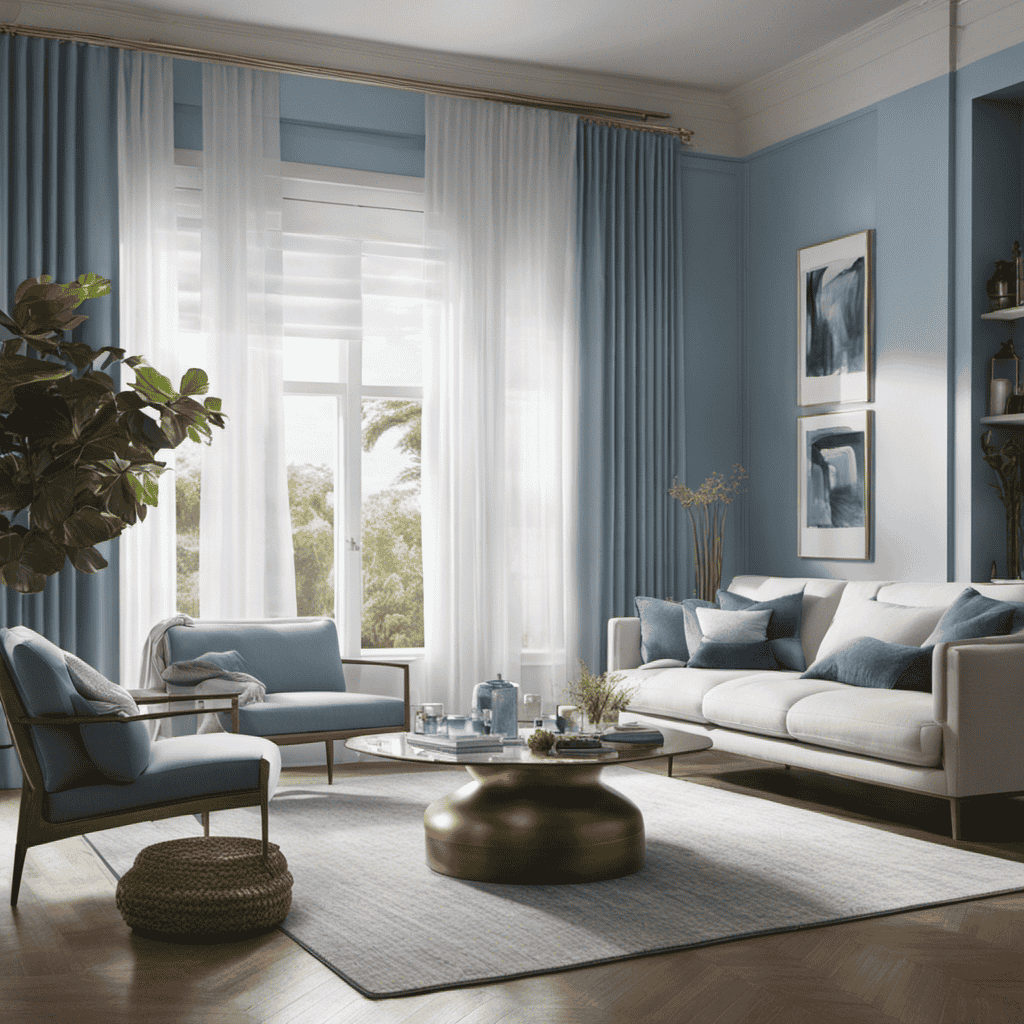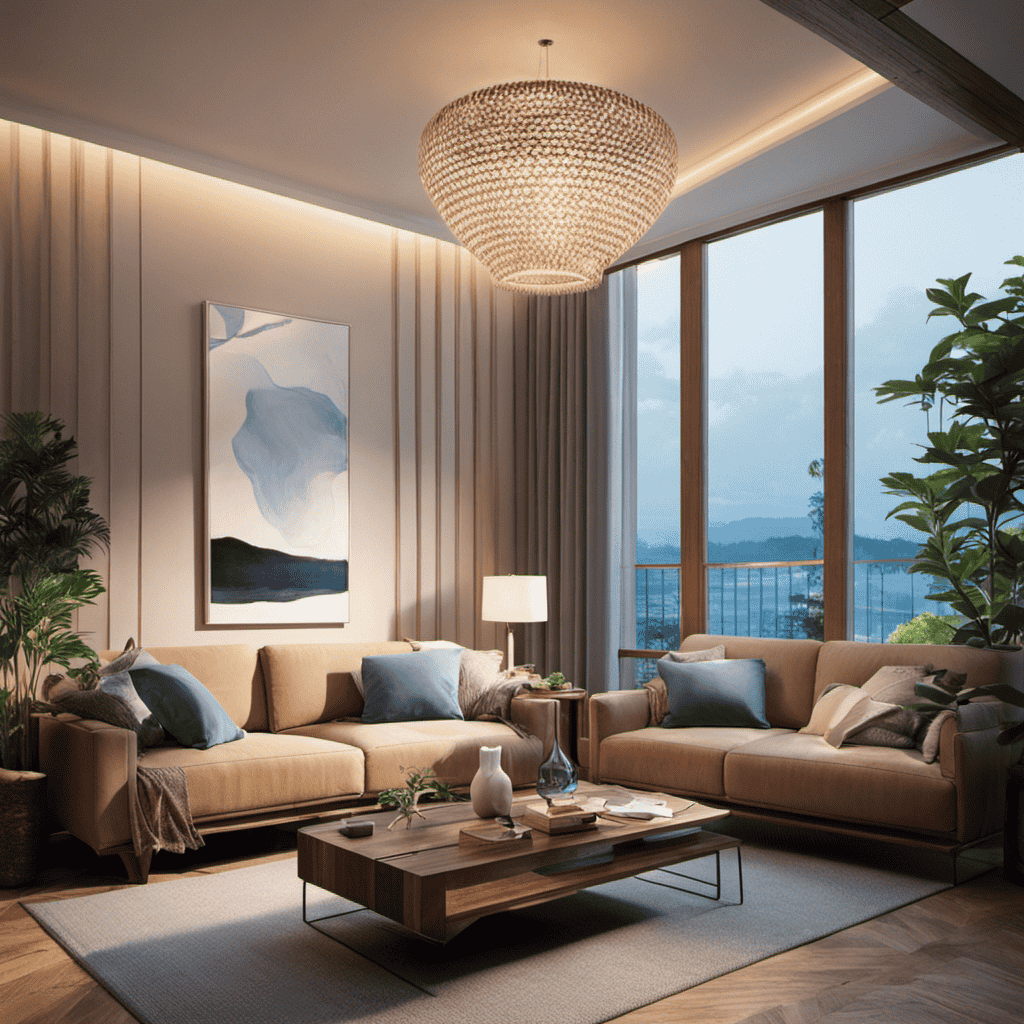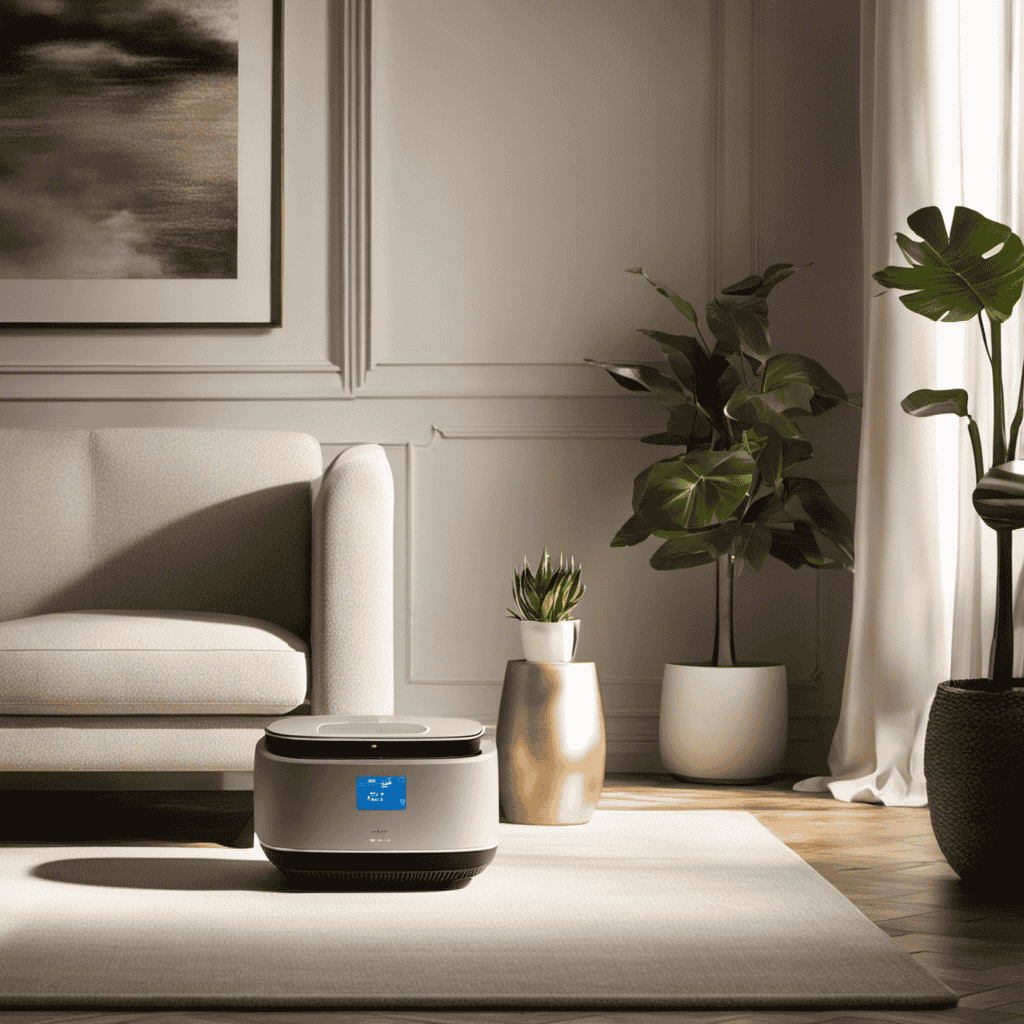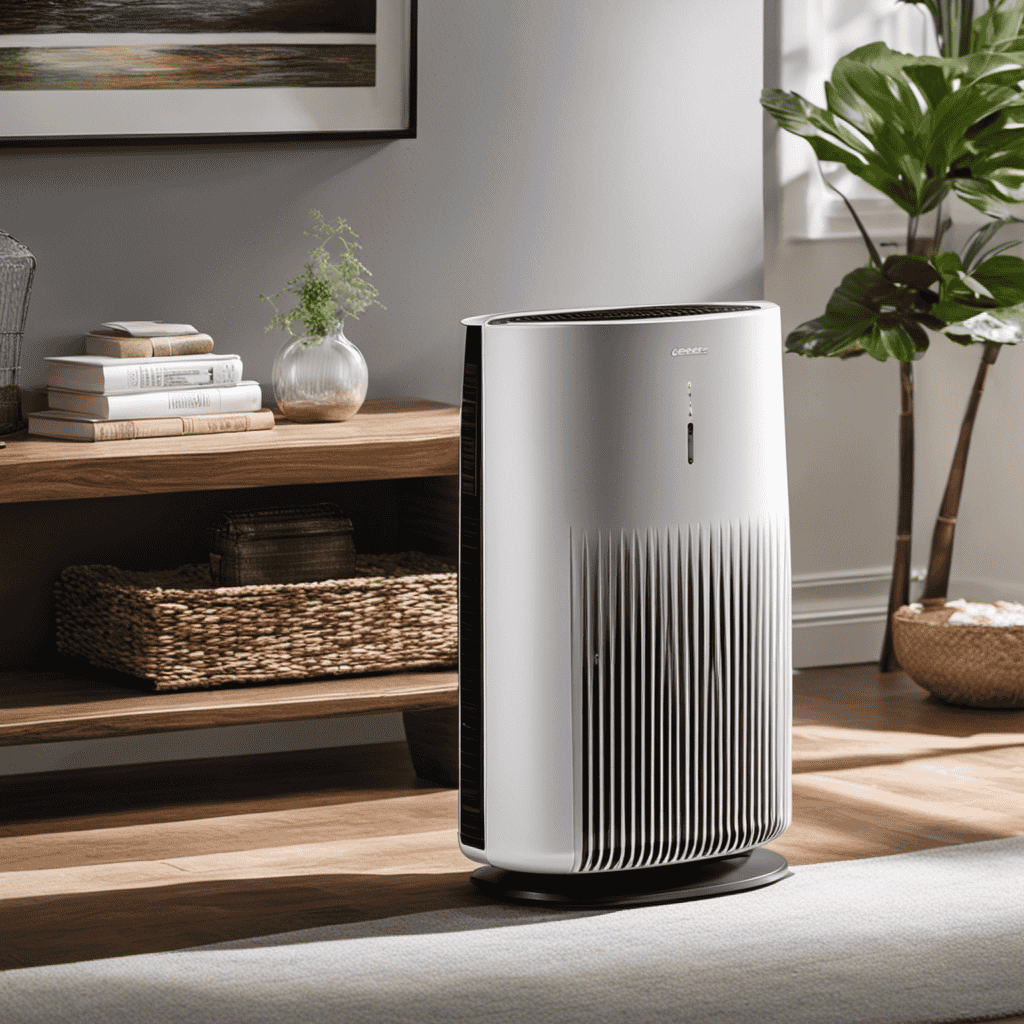Did you realize that the average American spends approximately 90% of their time indoors? With such a significant amount of time spent indoors, it is crucial to guarantee that the air we inhale is pure and beneficial. This is where air purifiers play a crucial role.
But how long should you actually run an air purifier to get the best results? In this article, I will explore the factors to consider and provide recommendations for how long you should run your air purifier in different situations, from reducing dust to removing odors.
So let’s dive in and find out the optimal air purifier runtime for your needs.
Key Takeaways
- Running an air purifier for at least 8 hours a day is recommended to ensure continuous air filtration and a clean living space.
- Adjusting the runtime based on personal preferences, room size, pollution level, and purifier capacity is important for optimal usage duration.
- Regular maintenance and filter replacement enhance the effectiveness of air purifiers.
- Balancing clean air and energy efficiency is important when considering runtime, and using energy-saving features like timers or smart sensors can help reduce energy consumption.
Importance of Running an Air Purifier
You should run an air purifier regularly to ensure the air in your home is clean and healthy.
The importance of air filtration cannot be overstated, as it plays a crucial role in maintaining good indoor air quality. Air purifiers are designed to remove various pollutants and contaminants from the air, such as dust, pollen, pet dander, mold spores, and even harmful bacteria and viruses.
By running an air purifier, you can effectively eliminate these pollutants, reducing the risk of allergies, asthma attacks, and other respiratory issues. Clean air has numerous benefits, including improved sleep quality, enhanced concentration and productivity, and a healthier immune system.
Investing in an air purifier and running it regularly is a simple yet effective way to ensure you and your family breathe clean and healthy air at all times.
Factors to Consider When Determining Air Purifier Runtime
When deciding how much to use your air purifier, take into account various factors. The recommended duration for running an air purifier depends on the size of the room, the level of air pollution, and the specific needs of the individuals in the space. If you live in a highly polluted area or have respiratory conditions, you may need to run the air purifier for longer periods of time.
Additionally, consider the noise level of the air purifier, as running it all day and night may disturb your sleep. It is also important to regularly clean and maintain your air purifier to ensure optimal performance. Taking these factors into consideration will help you determine the appropriate runtime for your air purifier.
In terms of the recommended daily usage for an air purifier, it is generally advised to run it continuously for a few hours each day. This allows the air purifier to effectively filter the air and remove pollutants. However, if you are concerned about energy consumption or noise, you can adjust the runtime accordingly.
For example, running the air purifier for a few hours in the evening when you are most likely to be indoors can be sufficient to maintain good air quality. Ultimately, the recommended daily usage will vary based on individual needs and preferences.
The Recommended Daily Usage for an Air Purifier
When it comes to the recommended daily usage for an air purifier, there are several key points to consider.
First, determining the optimal usage duration depends on factors such as the room size, the level of air pollution, and the specific needs of the individuals using the air purifier.
Second, understanding the health benefits achieved through consistent usage is crucial in deciding how long to run the air purifier each day.
Lastly, energy consumption considerations play a significant role in determining the recommended daily usage, as running the air purifier for extended periods can lead to higher electricity costs.
Optimal Usage Duration
To achieve the best results, it’s recommended to run an air purifier for at least 8 hours a day. Adjusting the runtime of your air purifier is crucial in ensuring a healthy environment free from pollutants.
Running the air purifier continuously for an extended period can help eliminate allergens, dust, pet dander, and other harmful particles effectively. By running it for a sufficient duration, you can significantly reduce the health risks associated with poor air quality, such as respiratory problems and allergies.
It’s important to note that the runtime can vary depending on factors like the size of the room, the level of pollution, and the air purifier’s capacity. However, running it for a minimum of 8 hours allows the purifier to continuously filter the air and maintain a clean living space.
Transitioning into the subsequent section, let’s explore the various health benefits achieved through optimal air purifier usage.
Health Benefits Achieved
Running an air purifier for a sufficient duration can significantly reduce health risks associated with poor air quality. Air purifiers are effective in improving indoor air quality by removing harmful pollutants and allergens. By continuously running the air purifier, it ensures that the air is constantly being filtered, providing a healthier and cleaner environment.
The duration for running an air purifier may vary depending on several factors, such as the size of the room, the level of air pollution, and individual sensitivities. However, it is generally recommended to run the air purifier for at least 8 hours a day to achieve noticeable health improvements.
Regularly replacing the filters and maintaining the air purifier in proper working condition also contributes to its effectiveness in improving indoor air quality and reducing health risks.
Energy Consumption Considerations
When considering how long to run an air purifier, it is important to take into account the energy consumption and its impact on the environment. Energy-saving tips can help minimize the environmental impact while still enjoying the benefits of clean air.
Here are some energy-saving tips to consider:
- Use a timer: Set the air purifier to run only when you are at home or in the room.
- Adjust the fan speed: Lowering the fan speed can reduce energy consumption while still maintaining air quality.
- Clean or replace filters regularly: Clogged filters can hinder airflow and force the purifier to work harder, consuming more energy.
- Opt for energy-efficient models: Look for air purifiers that are Energy Star certified, indicating their energy-saving capabilities.
How Long Should You Run an Air Purifier at Night
When it comes to running an air purifier at night, there are a few key points to consider.
Firstly, finding the optimal run time for your air purifier is essential in order to maximize its effectiveness without wasting energy. It’s important to determine the amount of time necessary to achieve the desired air quality and set a timer accordingly.
Secondly, energy consumption concerns are important to consider. Running the air purifier for too long can lead to higher electricity bills. It’s recommended to check the energy usage of the specific model you have and adjust the run time accordingly to strike a balance between clean air and energy efficiency.
Lastly, noise and disturbance can be a factor to take into account. This is especially important if you are a light sleeper or have a sensitive household. Some air purifiers can be noisy, so it’s essential to choose a model that operates quietly or has a night mode option to minimize disruption during sleep.
Overall, finding the right balance between optimal run time, energy consumption, and noise levels is crucial for running an air purifier at night effectively.
Optimal Run Time
The optimal run time for an air purifier is typically determined by the size of the room it is being used in. Air purifiers are designed to remove pollutants and allergens from the air, providing numerous health benefits. To ensure effective air purification, it is recommended to run the air purifier for a certain duration.
Here are some key factors to consider:
-
Room size: For smaller rooms, running the air purifier for a few hours a day may be sufficient. Larger rooms may require longer run times.
-
Air quality: If the air quality in your area is particularly poor, it may be beneficial to run the air purifier for longer periods.
-
Allergies or respiratory conditions: Individuals with allergies or respiratory conditions may benefit from running the air purifier continuously or for extended periods.
-
Occupancy: If the room is frequently occupied, it is recommended to run the air purifier continuously for optimal air quality maintenance.
Following these recommendations can help ensure that your air purifier effectively improves the air quality in your space and provides the desired health benefits.
Energy Consumption Concerns
One factor to consider when using an air purifier is the amount of energy it consumes. Energy consumption not only affects your electricity bill but also has an environmental impact. To help you save energy and reduce your carbon footprint, here are some energy-saving tips for using an air purifier:
| Energy Saving Tips | Environmental Impact |
|---|---|
| Use the lowest fan speed setting | Reduces energy consumption and noise |
| Set a timer for the air purifier | Ensures it runs only when needed |
| Keep doors and windows closed | Prevents the purifier from working harder |
| Clean and maintain the filters regularly | Improves efficiency and airflow |
| Consider an energy-efficient model | Saves energy in the long run |
Noise and Disturbance
Using the lowest fan speed on your air purifier can reduce noise and disturbance. When it comes to finding a quiet air purifier, consider the following:
-
Noise levels: Look for air purifiers that have a noise level rating of 50 decibels or lower. This ensures a quieter operation, especially during nighttime or in quiet environments.
-
Design features: Opt for air purifiers with noise-reducing design features, such as insulated housing, rubberized feet, or sound-absorbing materials. These can help minimize the noise generated by the fan and motor.
-
Sleep mode: Some air purifiers have a sleep mode that operates at an ultra-quiet level, allowing you to use them even in your bedroom without disturbance.
-
User reviews: Read reviews from other customers to get an idea of the noise levels and overall user experience of different air purifiers.
How Long Should You Run an Air Purifier in Different Seasons
In different seasons, it’s important to consider how long you should run an air purifier.
The runtime of an air purifier can vary depending on the size of the room and the air quality levels.
For smaller rooms, such as bedrooms or offices, running the air purifier for about 4 to 6 hours a day should be sufficient to maintain clean air.
Larger rooms, like living rooms or open spaces, may require longer runtime, ranging from 8 to 12 hours a day.
It’s also important to adjust the runtime based on the air quality levels. If the air quality is poor, due to factors like pollution or allergens, it’s recommended to increase the runtime to ensure continuous purification.
Conversely, during seasons with cleaner air, you may reduce the runtime accordingly.
The Impact of Room Size on Air Purifier Runtime
When considering the impact of room size on air purifier runtime, it’s important to understand how the size of a room can affect the efficiency of the air purifier.
A smaller room may require less time for the air purifier to effectively clean the air, while a larger room may require a longer runtime. This is because the air purifier needs sufficient time to circulate and filter the air in the room.
Additionally, the impact on allergies can also vary depending on the room size. A smaller room may experience a more noticeable improvement in air quality, leading to reduced allergy symptoms. On the other hand, a larger room may require additional measures, such as proper room ventilation, to fully address allergy concerns.
- Smaller rooms may require less time for air purifier runtime
- Larger rooms may require longer runtime for effective air purification
- Smaller rooms may experience more noticeable improvement in air quality
- Proper room ventilation may be necessary in larger rooms to address allergy concerns.
Signs That Indicate You Need to Run the Air Purifier Longer
If you notice an increase in dust or allergens in your home, it’s a sign that the air purifier may need to run longer. Adjusting the runtime based on air quality levels is crucial to ensure clean and healthy air. For asthma sufferers, it is especially important to maintain a recommended air purifier runtime to minimize triggers and improve respiratory health. Here is a table that provides a general guideline for air purifier runtime based on room size:
| Room Size | Recommended Runtime |
|---|---|
| Small | 4-6 hours |
| Medium | 6-8 hours |
| Large | 8-10 hours |
| Extra-Large | 10-12 hours |
| Open Space | 12+ hours |
Can You Overuse an Air Purifier
Overusing an air purifier can have negative effects on air quality and respiratory health. While air purifiers are designed to improve indoor air quality, using them excessively or incorrectly can lead to unintended consequences.
Here are some common misconceptions about air purifier usage that you should be aware of:
-
Leaving the air purifier on 24/7 will provide better air quality: Contrary to popular belief, running the air purifier continuously may not always be necessary. Most air purifiers are designed to clean the air within a specific room size and have recommended run times. Excessive usage can lead to increased energy consumption and may not yield significant improvements in air quality.
-
Neglecting air purifier maintenance: Regular maintenance, such as cleaning or replacing filters, is essential for optimal performance. Neglecting these tasks can result in reduced efficiency and compromised air purification.
-
Using the wrong type of air purifier: Different air purifiers are designed to target specific pollutants. Using the wrong type of purifier may not effectively address the air quality issues you are facing.
-
Believing that air purifiers can eliminate all pollutants: While air purifiers can remove many common allergens and pollutants, they may not eliminate all harmful substances from the air. It is important to have realistic expectations and employ multiple strategies, such as proper ventilation and keeping a clean living environment, to maintain good air quality.
Understanding these common misconceptions and practicing proper air purifier maintenance will help ensure that you are using your air purifier effectively and efficiently.
How Long Should You Run an Air Purifier for Allergy Relief
Running an air purifier can provide relief from allergies. When it comes to the ideal duration for running an air purifier, it depends on the severity of your allergies and the air quality in your home.
For effective usage, it is recommended to run the air purifier continuously or at least for a few hours a day. This allows the purifier to constantly filter out allergens and pollutants from the air, providing you with clean and fresh air to breathe.
However, it is also important to consider the noise level and energy consumption of the purifier. If you find it too noisy or if you want to conserve energy, you can run the purifier on a lower setting or for shorter periods of time.
Ultimately, finding the right balance between allergy relief and practicality is key.
Running an Air Purifier for Pet Owners
When it comes to living with pets, one of the biggest challenges for individuals with allergies is dealing with pet dander.
In this discussion, I will be exploring various techniques for removing pet dander from the air, as well as the importance of optimal air cleaning in reducing pet allergies.
Pet Dander Removal Techniques
To effectively remove pet dander from your home, you should regularly clean the air purifier’s filters. Pet dander can trigger allergies and cause respiratory issues, so it’s important to maintain your air purifier properly.
Here are some air purifier maintenance tips for pet owners:
- Clean or replace the filters every 3-6 months, or as recommended by the manufacturer.
- Vacuum the air purifier’s exterior regularly to remove dust and pet hair.
- Keep the air purifier in a well-ventilated area to ensure proper air circulation.
- Consider investing in a high-quality air purifier specifically designed for pet dander removal.
When choosing the best air purifiers for pet dander, look for models with HEPA filters, as they are highly effective at capturing small particles like pet dander. Additionally, consider air purifiers with activated carbon filters to eliminate pet odors.
Regular maintenance and using the right air purifier can greatly reduce pet dander in your home, providing a healthier environment for both you and your furry friend.
Optimal Air Cleaning
For optimal air cleaning, make sure you regularly clean or replace the filters in your air purifier. This is crucial for maintaining the effectiveness of your air purifier and ensuring continuous air quality improvement.
Filters are responsible for capturing and trapping airborne particles such as dust, pollen, pet dander, and pollutants, preventing them from circulating in the air you breathe. Over time, these filters can become clogged, reducing the efficiency of your air purifier.
Cleaning or replacing the filters according to the manufacturer’s instructions will help maintain the air purifier’s effectiveness and ensure that it continues to improve the air quality in your space.
Reducing Pet Allergies
Regularly cleaning or replacing filters in your air purifier is crucial for reducing pet allergies and improving indoor air quality. Pet hair management is an essential part of allergy prevention strategies. Here are some important points to consider:
- Brush your pets regularly to minimize shedding.
- Vacuum your home frequently, using a vacuum cleaner with a HEPA filter to trap pet dander.
- Wash your pet’s bedding and other soft surfaces regularly to remove allergens.
- Consider using allergen-proof covers on pillows and mattresses to prevent pet dander from settling.
By implementing these measures, you can significantly reduce the amount of pet dander in your home and alleviate allergy symptoms.
Remember to check your air purifier’s filters regularly and follow the manufacturer’s instructions for cleaning or replacing them. This will ensure that your air purifier functions optimally and effectively removes pet allergens from the air.
The Role of Air Quality in Determining Air Purifier Runtime
You should consider the role of air quality in determining how long you should run an air purifier. Proper air purifier maintenance and regular air quality monitoring are essential for maintaining a healthy indoor environment. Monitoring the air quality allows you to assess the level of pollutants present, such as dust, allergens, and volatile organic compounds (VOCs). By understanding the quality of the air, you can adjust the runtime of your air purifier accordingly. For instance, if the air quality is poor, with high levels of pollutants, you may need to run the air purifier for longer periods to effectively remove contaminants. On the other hand, if the air quality is relatively good, you may only need to run the air purifier intermittently. By considering the air quality, you can optimize the runtime of your air purifier and ensure a clean and healthy indoor environment.
| Air Quality Level | Recommended Air Purifier Runtime |
|---|---|
| Poor | Longer periods |
| Moderate | Moderate periods |
| Good | Intermittent periods |
| Excellent | Minimal periods |
| Optimal | Minimal periods |
Considering the air quality is crucial in determining how long you should run an air purifier. However, another important factor to consider is how long you should run an air purifier to remove odors.
How Long Should You Run an Air Purifier to Remove Odors
Consider the duration needed to eliminate odors using an air purifier. When it comes to effective odor removal, running an air purifier for the optimal duration is crucial. Here are a few key points to keep in mind:
-
Size of the room: The larger the room, the longer it may take to completely remove odors. A larger space requires more time for the air purifier to circulate and clean the air effectively.
-
Intensity of the odor: Strong and pungent odors may require a longer duration of operation. It may take some time for the air purifier to eliminate these stubborn smells completely.
-
Air purifier type and features: Different air purifiers have various filtration systems and settings that can affect the duration needed for odor removal. Higher-end models with advanced features may provide faster results.
-
Maintenance and filter replacement: Regular maintenance and timely filter replacement are essential for optimal performance. Neglecting these tasks can prolong the odor removal process.
The Relationship Between Air Purifier Runtime and Energy Consumption
When it comes to air purifiers, finding the optimal runtime is crucial for achieving efficiency.
Not only does it affect the air purification process, but it also has a significant impact on energy consumption and, consequently, energy bills.
Balancing the need for clean air with energy efficiency is a key consideration for users, as it ensures a healthy indoor environment without unnecessarily increasing energy costs.
Optimal Runtime for Efficiency
The optimal runtime for an air purifier to maximize efficiency is typically around 8-12 hours per day. This range allows the air purifier enough time to effectively filter the air in a room without wasting energy or overworking the device.
Here are a few reasons why this recommended air purifier usage is beneficial:
- Reduces energy consumption: Running the air purifier for a shorter duration helps conserve energy and lower utility bills.
- Promotes healthy sleep: Using the air purifier during sleep hours ensures cleaner air in the bedroom, improving sleep quality.
- Extends filter life: Limited runtime prevents the filter from getting clogged too quickly, extending its lifespan.
- Balances noise level: Longer runtime can lead to increased noise, while shorter intervals help maintain a quieter environment.
Impact on Energy Bills
To save on energy bills, make sure to limit the amount of time you run the air purifier. Running it continuously can significantly contribute to your monthly energy consumption, resulting in higher costs.
It is important to strike a balance between maintaining clean indoor air and reducing environmental impact. One way to achieve this is by using the air purifier only when necessary, such as during periods of high pollution or when there are specific indoor air quality concerns.
Additionally, consider using features like a timer or smart sensors that automatically adjust the runtime based on air quality levels. This can help optimize the usage of the air purifier and make it more cost-effective in the long run.
Balancing Clean Air Needs
Maintaining a balance between clean air needs and energy efficiency is crucial. When it comes to finding the right air purifier, there are a few key factors to consider.
Firstly, look for a purifier that is suitable for the size of the room you want to use it in. This will ensure that it effectively cleans the air without using excessive energy.
Secondly, consider the noise level of the purifier. Some models can be quite loud, which can be disruptive, especially if you plan to use it in a bedroom or office. Look for a purifier that has a noise level that is comfortable for you.
Lastly, remember to clean or replace the filters regularly to maintain the efficiency of the purifier.
How Long Should You Run an Air Purifier to Reduce Dust
For optimal reduction of dust, you should run an air purifier for at least six to eight hours a day. Determining the effectiveness of an air purifier depends on various factors, including the size of the room, the level of dust present, and the air purifier’s specifications.
Running the air purifier within the recommended runtime ensures that it continuously filters the air, removing dust particles and improving the overall air quality. By running the air purifier for this duration, you allow enough time for it to circulate and filter the air multiple times, effectively capturing and trapping dust particles.
It is essential to follow the recommended runtime to achieve the desired results and maintain a dust-free environment in your home or office.
Adjusting Air Purifier Runtime Based on Specific Needs and Goals
Adjusting the air purifier’s runtime based on specific needs and goals allows for a more customized approach to improving air quality. By considering factors such as room size and the types of air pollutants present, one can determine the ideal runtime for their air purifier.
Here are some key points to consider:
-
Room size: Larger rooms may require a longer runtime to effectively clean the air, while smaller rooms may need less time.
-
Air pollutants: Different pollutants may require varying amounts of time to be effectively filtered. For example, volatile organic compounds (VOCs) may require a longer runtime compared to dust particles.
-
Personal preferences: Some individuals may be more sensitive to certain pollutants, necessitating a longer runtime to achieve their desired level of air quality.
-
Time of day: Adjusting the air purifier’s runtime based on when the room is most occupied can optimize its effectiveness.
Frequently Asked Questions
Can Running an Air Purifier for Too Long Be Harmful?
Running an air purifier for too long can have pros and cons. On one hand, it can improve air quality, but on the other hand, it can increase energy consumption and costs.
How Do I Determine the Specific Runtime for My Air Purifier Based on My Needs?
To determine the optimal duration for running an air purifier based on your needs, consider factors like room size, air quality, and personal sensitivities. Experiment with different runtimes to find what works best for you.
Are There Any Health Risks Associated With Running an Air Purifier for Extended Periods?
There might be potential health risks associated with running an air purifier for extended periods. It’s important to understand the recommended air purifier runtime for different health conditions to mitigate any negative effects.
Can Running an Air Purifier for a Shorter Duration Still Provide Effective Results?
Running an air purifier for shorter durations may not provide optimal results. To ensure air purifier effectiveness, it is recommended to run it for the recommended runtime.
How Does the Size of the Room Affect the Recommended Air Purifier Runtime?
When choosing the right size air purifier, it’s important to consider the size of the room. The size of the air purifier can affect its effectiveness in filtering the air efficiently.
Conclusion
In conclusion, running an air purifier is absolutely crucial for maintaining a clean and healthy environment. With factors like daily usage, nighttime operation, and seasonal variations, it’s important to find the perfect balance for maximum effectiveness.
Whether you’re trying to eliminate odors, reduce dust, or simply improve air quality, the right air purifier runtime can work wonders. And don’t worry about energy consumption – these devices are designed to be efficient.
So go ahead, run that air purifier and breathe in the freshest air you’ve ever experienced!










